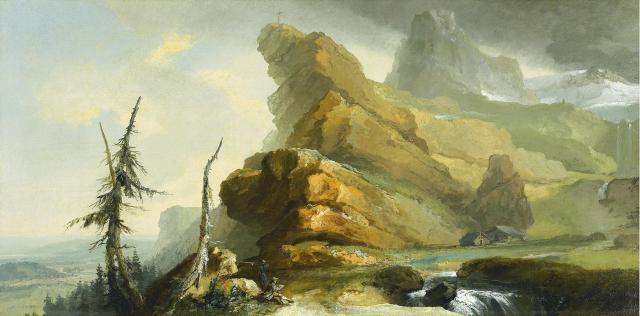From 1773 to 1779, Caspar Wolf throws himself into an artistic adventure that is rather ambitious for the time. Heartened by various exchanges with a group of geologists and intellectuals, the painter sets off with them on an expedition to discover a part of the world that is still relatively unknown, the high mountains, a region that has been left unexplored for centuries.
Abraham Wagner takes part in the first excursion of 1773. The Bernese publisher sees in Wolf the artist who will produce for him the models needed for a planned series of engravings on the Alps. He proposes an exceptional commission, a series of two hundred paintings. Wolf accepts the challenge and starts off, accompanied by his assistant Caspar Wyss. Equipped with a paintbox, he draws from life, sometimes sketches directly in oil and scrupulously notes down all his observations. Back in the studio, he gathers his different annotations and composes an oil painting, always working in the very same format (54 x 82 cm or 82 x 54 cm). Occasionally, out of his regard for realism, Wolf returns to a site with his rolled up canvas to verify the details.
In five years he indeed executes the two hundred paintings making up this commercial venture. The pictures are exhibited twice, in Bern and Paris, but unfortunately they don’t have the success the publisher and painter had expected. The works, however, do have a certain influence thanks to the publication of Vues remarquables (Remarkable Views), which features plates engraved from Wolf’s work.
During the same period, on the margins of his major undertaking, Wolf paints Ideale Hochgebirgslandschaft mit Ausblick auf eine weites hügeliges Tal (Ideal High-Mountain Landscape with a View of a Rolling Valley in the Distance), albeit in a slightly larger format (51.5 x 102 cm). The high alpine region is depicted ideally, as the artist imagines it, with a waterfall on the right and two small figures in the foreground. One of them is none other than Wolf, who often portrays himself wearing a red frock coat and painting nature, as if to better attest that he had actually been to the hard-to-reach sites. The presence of human figures also makes the landscapes look all the more monumental.
Abraham Wagner takes part in the first excursion of 1773. The Bernese publisher sees in Wolf the artist who will produce for him the models needed for a planned series of engravings on the Alps. He proposes an exceptional commission, a series of two hundred paintings. Wolf accepts the challenge and starts off, accompanied by his assistant Caspar Wyss. Equipped with a paintbox, he draws from life, sometimes sketches directly in oil and scrupulously notes down all his observations. Back in the studio, he gathers his different annotations and composes an oil painting, always working in the very same format (54 x 82 cm or 82 x 54 cm). Occasionally, out of his regard for realism, Wolf returns to a site with his rolled up canvas to verify the details.
In five years he indeed executes the two hundred paintings making up this commercial venture. The pictures are exhibited twice, in Bern and Paris, but unfortunately they don’t have the success the publisher and painter had expected. The works, however, do have a certain influence thanks to the publication of Vues remarquables (Remarkable Views), which features plates engraved from Wolf’s work.
During the same period, on the margins of his major undertaking, Wolf paints Ideale Hochgebirgslandschaft mit Ausblick auf eine weites hügeliges Tal (Ideal High-Mountain Landscape with a View of a Rolling Valley in the Distance), albeit in a slightly larger format (51.5 x 102 cm). The high alpine region is depicted ideally, as the artist imagines it, with a waterfall on the right and two small figures in the foreground. One of them is none other than Wolf, who often portrays himself wearing a red frock coat and painting nature, as if to better attest that he had actually been to the hard-to-reach sites. The presence of human figures also makes the landscapes look all the more monumental.
